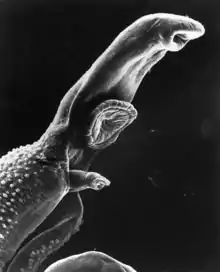Gonochorism
In biology, gonochorism or unisexualism or gonochory describes the state of having just one of at least two distinct sexes in any one individual organism.[1]
Etymology
| Look up gonochorism in Wiktionary, the free dictionary. |
The term is derived from new Greek γόνος (gonos, offspring) + χορους (chorous, dance / disperse).
Use for plants and animals
The term is most often used with animals, in which the individual organisms are often gonochorous.
Gonochory is less common in plants, and plants which have single-sex individuals are typically called dioecious instead. For example, in flowering plants, individual flowers may be hermaphroditic (i.e. with both stamens and ovaries) or gonochorous (unisexual), having either no stamens (i.e. no male parts) or no ovaries (i.e. no female parts). Among flowering plants with unisexual flowers, some also produce hermaphrodite flowers, and the three types may occur in different arrangements on the same or separate plants; species can thus be monoecious, dioecious, trioecious, polygamomonoecious, polygamodioecious, andromonoecious, or gynomonoecious.

Sex is most often genetically determined, but may be determined by other mechanisms. For example, alligators use temperature-dependent sex determination during egg incubation. Examples of gonochoric or dioecious pollination include hollies and kiwifruit. In these plants the male plant that supplies the pollen is referred to as the pollenizer.
Other reproductive strategies
Gonochorism stands in contrast to other reproductive strategies such as asexual reproduction and hermaphroditism. Closely related taxa can have differing sexual strategies – for example, the genus Ophryotrocha contains species that are gonochoristic and species that are hermaphrodites.[2]
The sex of an individual may also change during its lifetime – this sequential hermaphroditism can for example be found in parrotfish[3][4] and cockles.
See also
Notes
- "Gonochorism". Glossary. The Natural History Museum. Retrieved 11 April 2012.
- Prevedelli, Daniela; Massamba N'Siala, Gloria; Simonomi, Roberto (January 2006). "Gonochorism vs. hermaphroditism: relationship between life history and fitness in three species of Ophryotrocha (Polychaeta: Dorvilleidae) with different forms of sexuality". Journal of Animal Ecology. 75 (1). doi:10.1111/j.1365-2656.2006.01040.x. Retrieved 28 November 2020.
- Bester, C. Stoplight parrotfish. Florida Museum of Natural History, Ichthyology Department. Accessed 2009-12-15
- Afonsoa, Moratoa, & Santos (2008). Spatial patterns in reproductive traits of the temperate parrotfish Sparisoma cretense. Fisheries Research, 90(1-3): 92-99
